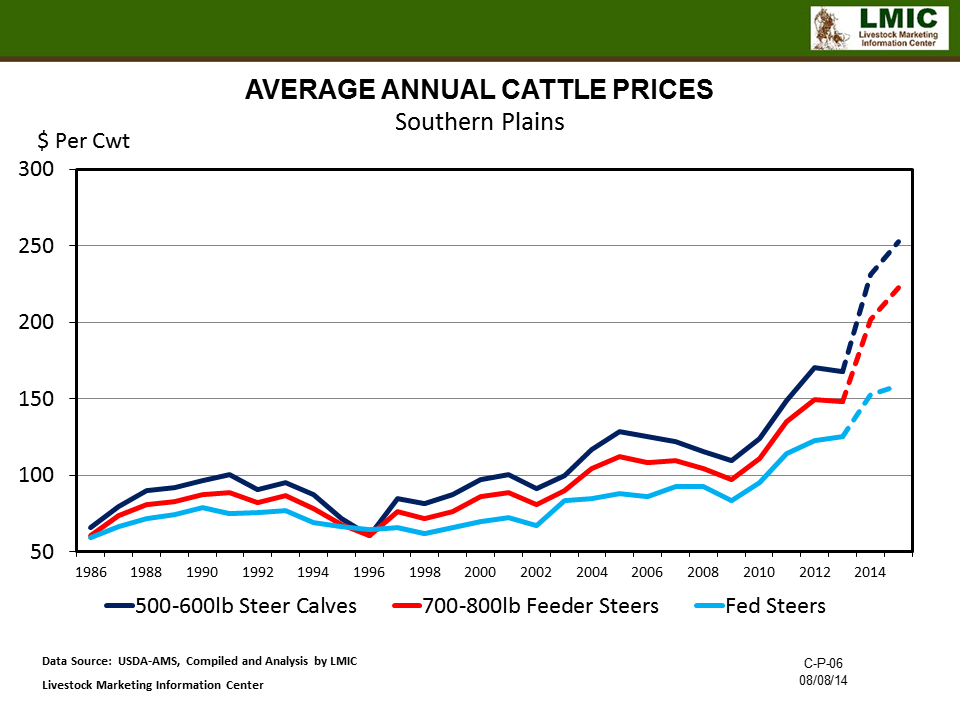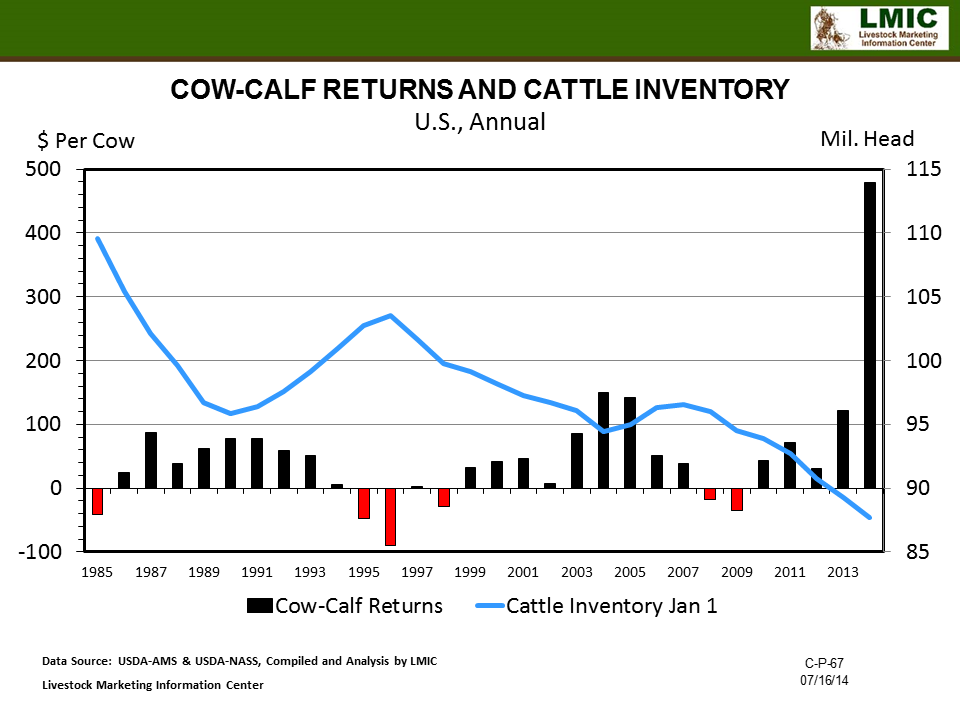Consider Investments in Efficiency with Extra Cattle Income
Most cattlemen have a noticeable grin on their faces these days. Cattle have been selling for record prices this summer as seen in Chart 1 above. What is causing this major increase in prices? Primarily there are two key factors: fewer cattle, and cheaper feed. Chart 2 below shows the drastic decline in the national cattle inventory and the effect it has had on profitability. A good portion of this herd reduction is due to the long-term drought in the central plains and other areas of the country. For the past several years ranchers in drought zones have been forced into cow herd reduction. There was not enough grass to support the number of cows that had been traditionally grazed, and a good number of the cows sold went to slaughter.
Anyone who has watched commodity markets in the farming business knows high prices are temporary. With every drop in national inventory, a price increase follows. It is simple supply and demand economics. Generally, herd expansion follows to take advantage of the higher prices and higher profits. But unlike most crop commodities, it takes years to rebuild a national cow herd. With fewer cattle nationwide, prices should remain strong, unless a complicating factor such as high feed prices, or reduced consumption holds the prices down. While feed prices have been known to fluctuate, the best estimates available suggest a continued surplus of corn. Higher cattle prices have naturally affected retail beef prices. So far, consumers have not drastically reduced beef purchases, but every cattleman worries that people will back off of beef consumption, as prices move higher. Barring some major changes in feed prices or beef demand, however, the cattle market should remain strong for the next few years.
The key question then for cattle ranchers to consider is,
How to reinvest the extra income from the good years to remain profitable over the long haul when prices come back down?
-
Enjoy the extra income a little.
Many farms are diversified with multiple crops and income sources, so for many farms the extra cattle income will simply be lifting the farm income, while other commodities are lower this year. Even so, take the time and a few dollars to celebrate with family the blessings of an excellent cattle market.
-
Pay Off Debt
Certainly debt is an integral part of most farming businesses. Having some extra dollars may provide an opportunity to reduce the interest load on the farm. Leaner times will return, so lowering debt could be the best investment to farm profits in the long run.
-
Improve Resources of the Operation
If there are funds available to reinvest in the cattle operation, the following are some ideas worth considering. The main idea is to improve the productivity and efficiency of the operation with the extra income that may not be available in future years.
-
Cowpens
Stress on cattle can be greatly reduced with calmer, smoother cattle handling. Most years there is not enough income for overhauling cowpens, so patchwork is constantly required. For many operations some extra income this year, and next, might provide the ability to make improvements that pay off for years to come. Think about where cattle are the most difficult to handle, where things break frequently, and what improvements could be made for work that might begin during the cooler months ahead. Lower stress in the cowpens means cattle maintain more weight and earn more money for the operation every time a group goes to market.
-
Pastures
Pasture renovation is another large expense that can also provide more feed for the herd for years to come. This might be the year to look over your fields and select one that is below par for renovation. Fall is the best time to kill grasses and grass weeds, like centipede. Plus, if you kill it in the next month or so, you could even plant winter grazing and then follow with Bahia late next Spring or in early summer. If the existing grass is healthy but perennial weeds like blackberry briars are the problem, fall is also an excellent time of the year to control them. Whether it is completely starting over or simply doing some expensive weed control, making an investment in improving pastures can pay dividends for years to come.
-
Genetics through Timed AI
One of the practices that has truly benefited the NFREC beef herd and many others around the country is the use of Synchronization and Timed Artificial Insemination (TAI). In his article, An Economic Evaluation of Estrous Synchronization and Fixed-Time Artificial Insemination in Suckled Beef Cows, Dr. Cliff Lamb explains the results of a Timed AI research trial on a number of large herds that resulted in a $49 per cow return on investment, as compared to those in a traditional natural breeding system. Even if there is not enough extra income to invest in synchronization and AI of the entire herd, the heifers and the very top cows can be bred early in the season to some of the best bulls in the country with this system. The improvement in genetic performance from AI will last for generations within a herd.
-
Cross-Fences
Grazing management is a key aspect of pasture management. Investing in cross fencing can make pastures more productive for years to come. Providing more rest for the pasture grasses due to a better herd rotation system, could mean less purchased feed is required, or stocking rates could be increased to some degree. It might also reduce weed problems, because with additional rest the perennial grasses can do a better job choking out the competition. Cross-fencing is an approved practice in the NRCS EQIP Program which provides approximately a 50% cost share to approved conservation practices. Utilizing the EQIP program can make the extra cattle income go even further and allow ranchers a key tool to better manage pastures for years to come.
-
Hay or Bulk Feed Barn
Barns are a considerable investment that will require more than one year’s extra income. However, feed is a major portion of the annual carrying costs for a cow herd. Hay is expensive to grow, harvest, and feed. Very few investments of the magnitude of annual hay crop are left to weather and deteriorate in the field with 20-30% storage losses. The book Forage Livestock Quotes & Concepts has a great quote: “Some folks pay for a barn they have never built”. The point of the quote is that if you don’t store hay in a barn, then you are losing both dry matter and nutrients from the hay with every rainfall. While bulk feed is not required for cattle ranching, many have found significant cost savings from buying feed by the truckload. The challenge is dry storage and the ability to handle the feed once offloaded from the truck. So whether a barn is built for hay, feed storage, or both this could be an investment that improves the efficiency of an operation.
-
Cattle ID and Record Software
Some of the best advice shared by successful ranchers is to make the investment in individual animal identification. Once each animal has individual identification, you have to develop a record system to evaluate the performance of each animal. There are some excellent computer programs available on the market that can sort herds based on age and performance. It will be challenging to improve the efficiency of a herd without knowing which individuals in the herd are the most productive. If you are not interested in computers, there is a free Florida Ranch Record Book you can download that provides sheets for individual cow records. Investing in a production record system will certainly assist with improving the efficiency of a cow herd for years to come.
Investments to Be Cautious Of
There are some investments that should be made very cautiously. Large purchases that cannot be paid off immediately could add a financial burden to the ranch, when prices do fall again.
-
Buying Additional Cattle
It is only natural to consider herd expansion during high markets, but remember the wise old adage of investment. “Sell high and buy low.” All indicators are that cattle prices will remain high for at least another year and perhaps more, but young cattle purchased in today’s market will have years of productivity ahead with lower returns. A bred two-year old should have at least 6-8 years of productive life in the herd, so keep that in mind if you decide to shop for cattle. Recently weaned replacement heifers are worth what bred heifers sold for just a few years ago. Keeping more of your own heifers would be a lower risk investment than purchasing bred 2-year old heifers from someone else.
-
Buying Expensive Equipment
A new (or new-to–you) pickup truck or tractor may be a good investment, but adding more debt to the farm could be crippling several years from now, when cattle prices begin to fall. Do your budgeting with more conservative figures than today’s market, before making that purchasing decision. Be careful of equipment that would be nice to have versus equipment that can actually make the operation more efficient. It might be nice to have your own hay equipment, but if you are not going to bale enough hay to gain a return on the investment, it could be challenging for a small herd to pay for it.
The main point is to take some time considering how to invest your extra cattle income over the next few years. The decisions you make now could affect the long-term profitability of your herd, when markets flatten and then fall.


